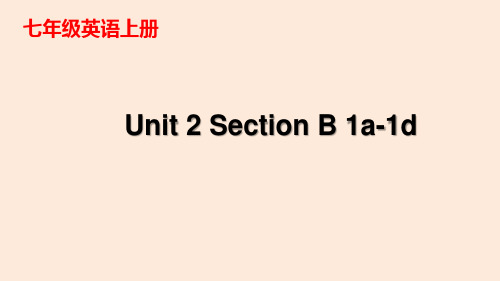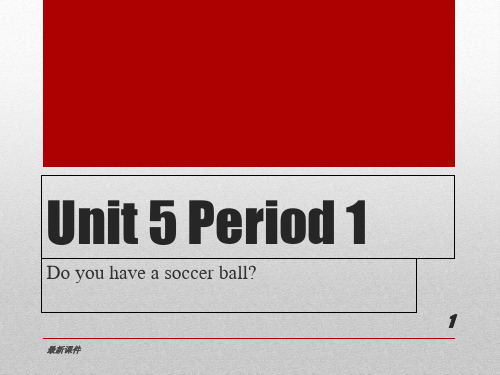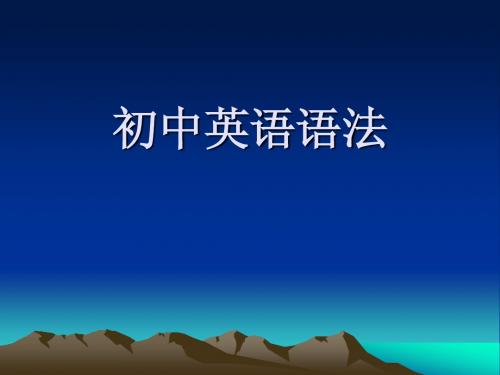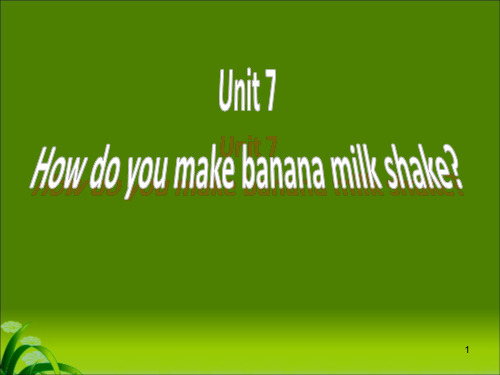初中英语课件课件
合集下载
初中英语说课全英文ppt课件ppt课件

Regular tests, home work, and participation grades to monitor students' progress
02
Course Content
Course Structure
Welcome Page Course objectives and introduction
Vocabulary focus
Free time activities, travel and accommodation
Course Structure
Unit 6
Farewell and review
Grammar focus
Subjunctive and reported speech
Vocabulary focus
Language Fuovered include introducing yourself and others, describing daily routines, describing school life, ordering food in a restaurant, using public transport, describing hobbies and interests, making arrangements for meetings and travel, and expressing farewells
covers a range of topics to engage students in real life
situations and stimulate their interest in learning English
Multimedia Material
初中英语课件ppt免费

Regularly assess the listening level of students in order to identify and solve problems in a timely manner.
13
Oral expression strategies and imitation training
2
目录
2024/1/25
• Improving reading comprehension and writing skills
• Cultural background knowledge and expansion of cross-cultural communication skills
• Examination Skills Guidance and Preparation Suggestions
• Attributive clauses and adverbial clauses: Learn the guide words, word order, and usage of attributive clauses and adverbial clauses.
2024/1/25
11
03
Listening training and oral expression ability
Auxiliary materials
Provide rich listening, speaking, reading, and writing practice materials to help students consolidate their knowledge.
7
02
Basic knowledge of phonetics, vocabulary,
13
Oral expression strategies and imitation training
2
目录
2024/1/25
• Improving reading comprehension and writing skills
• Cultural background knowledge and expansion of cross-cultural communication skills
• Examination Skills Guidance and Preparation Suggestions
• Attributive clauses and adverbial clauses: Learn the guide words, word order, and usage of attributive clauses and adverbial clauses.
2024/1/25
11
03
Listening training and oral expression ability
Auxiliary materials
Provide rich listening, speaking, reading, and writing practice materials to help students consolidate their knowledge.
7
02
Basic knowledge of phonetics, vocabulary,
初中英语六种时态复习课件(35张PPT)

②while 引导的从句表示“在……期间”,主从句谓语动词所表示的动 作同时ቤተ መጻሕፍቲ ባይዱ生。这时,主从句都用过去进行时。
e.g.:My father was reading the newspaper while my mother was watching TV.当我的妈妈看电视的时候,我的爸爸正在看报纸。
(2)表示普遍真理或客观事实。 e.g.:The sun rises in the east.太阳从东方升起。 (3)在条件状语从句和时间状语从句中,用一般现在时表示将来。 e.g.:If it doesn't rain tomorrow,we will go for a picnic.如果明天不下 雨,我们将去野餐。 (4)在某些以 here,there 开头的句子中用一般现在时表示正在发生的动作。 e.g.:There goes the bell.铃响了。
(3)现在进行时表示将来 表示位置移动的动词 go,come,leave,fly,start,meet,move 等, 可以用现在进行时表示将要发生的事。 e.g.:We are leaving for London.我们就要动身去伦敦了。
(4)一般现在时表示将来 ①表示按规定或时间表预计要发生的动作。 e.g.:Our plane takes off at 8:10.我们的飞机 8:10 起飞。 ②当主句为一般将来时,或含有情态动词,或是祈使句时,在 if,as soon as,until,when 等引导的状语从句中用一般现在时表示将来。 e.g.:I will give him the book as soon as he comes here.他一来这儿, 我就把这本书给他。
(2)表示当前一段时间内的活动或现阶段正在进行的动作。 e.g.:They are picking apples on a farm all the time.他们一直在农场 摘苹果。 (3)与 always,usually 等词连用,表达说话人强烈的感情,如赞扬、不 满、讨厌等。 e.g.:Mary is always thinking of others instead of herself.玛丽总是为 别人着想,而不为自己着想。
初中英语课件优秀PPT课件

F
5.Ben could not sleep all the night.
F
Choose the right answers 精挑细选
(B) 1.What was the weather like before the storm
started?
A sunny
B cloudy
C rainy
(A) 2.What was Ben doing when it rained heavily ?
时光一过就是三十多年,近日,机缘 成熟, 与好友 登临金 鸡山, 走近金 鸡石, 终于圆 此一梦 。 经向老乡打听,金鸡山北面,我小时 候曾经 砍柴叫 坦洼的 地方, 荆棘丛 生,难 以登山 。老乡 建议开 车上四 岭,将 车停于 金鸡队 ,再从 南面登 山,那 儿已修 了一条 简易的 山路可 直达山 顶。 早晨九点,从城区出发,到马衙,再 转而向 南,经 九华天 池景区 外围, 沿上山 公路行 驶。一 路景色 秀美, 空气清 新,万 物柔顺 地沫浴 在冬日 暖阳中 ,静静 地接受 阳光的 滋养。 闭上眼 睛,你 都会感 受到这 优雅之 境的温 馨慈祥! 参观新四军七师沿江团团部旧址纪念 馆是我 们此行 计划之 一。山 路边一 块指示 牌将我 们带进 一个古 老的小 山村— —院冲 杨,这 里四面 青山环 抱,竹 海茫茫 ,环境 十分清 幽。19 45年春 夏之交 ,新四 军七师 沿江支 队沿江 团团部 及其主 力大部 驻扎在 院冲杨 ,眼前 这座有 着200 多年历 史的杨 氏祠堂 就是当 年团部 办公的 场所。 说来也巧,在这里竟然遇见了我的大 姑父, 他正在 这儿砍 毛竹。 在他的 帮助下 ,负责 管理纪 念馆的 乡亲打 开了大 门,让 我们进 去参观 。纪念 馆里陈 列着新 四军七 师沿江 团当年 抗战使 用过的 一些实 物,包 括军用 品和生 活用品 ,墙上 悬挂着 沿江团 的革命 事迹和 人物介 绍,让 人非常 直观地 感受那 个烽火 连天的 革命岁 月。同 行安先 生,从 头到尾 细读金 鸡山阻 击战的 故事, 那样认 真、投 入…… 告别院冲杨,继续向山中进发。山路 蜿蜒曲 折,途 经九华 天池尾 端,整 个天池 呈现在 眼前, 还能隐 隐约约 望见远 处的大 坝。沿 途零星 散落着 几个小 村庄, 静谧安 祥,几 个年龄 较长的 村民正 在忙碌 着农活 。路过 沈家冲 ,前面 就是金 鸡队。 我们将 车停在 金鸡队 一块空 地上, 开始步 行上山 。
名词(30张PPT)初中英语专题复习课件

(2)可数名词复数的不规则变化
不规则变化 ① 变化元音字母构成复数 ② 单复数形式相同
示例 foot→ feet, goose→ geese, tooth→ teeth, man→ men, woman→ women sheep, deer, fish (注意:fish指鱼的数量时单复数同形 ;指鱼的种类时复数是fishes)
初中英语专题复习
名词
名词概述 名词属于十大词类中的一种,主要包括普通名词和专 有名词两种。纵观近几年中考对于名词的考查,主要以 选择题和填空题为主,考查内容以词义理解、名词所有 格及词形转换居多。在中考备考时,注意掌握名词变复 数的变化规则,掌握不可数名词向可数名词转化的规律, 名词所有格的用法,名词的句法功能等,并做到灵活运 用,以便提高综合运用能力。
8. trip, journey, travel和voyage
词条 trip journey travel voyage
用法 指短期的具有特定目的的旅行
指稍长的旅途 是最常用的,指旅行或普通出行
指海上航行
核心考点提炼·考向探究
中考高频易混易错名词梳理
9. sport和game
词条 sport game
(3)有些名词既可作可数名词,又可作不可数名词,但意思不同。
名词
词义
可数
不可数
名词
词义
可数
不可数
change chicken exercise experience
fish
变化 小鸡 习题 经历 鱼(类)
零钱 鸡肉 锻炼 经验 鱼肉
glass light orange room time
玻璃杯 电灯 橙子 房间 次数;倍数
用于有生命的及表示 时间、距离、国家、
初中英语零基础学语法--英语句子结构 课件(共43张PPT)

附属成分
基本成分的修饰语。可以是: • 定语:即用来修饰名词的单词、短语或从句 • 状语:即用来修饰名词或代词以外的词的单词、短语或从句。
定语
Poor John tottered toward a hospital nearby. She likes oranges imported from the USA.
省略成分
句中被省略的成分,虽然未说出来,却在句中表示 一定的意思:
(You) Come here. (I wish you)Good luck! Some gave him praises,but others(gave him)rotten eggs.
He runs as fast as, if ( he does ) not ( run ) faster, than you. ( I ) Hope you like it. John should clean the room today and Peter ( should clean it ) tomorrow.
主语、动词(不及物动词、及物动词、双宾动词、系动词、宾 补动词)、宾语及补语可以称为基本句子成分。完整的句子一 般至少包含2个基本成分,至多4个基本成分。
Vi(不及物动词)
主 语
谓 语
Vt(及物动词)
宾语 宾语(直) 宾语(间) 宾语 宾补
系动词
表语
be / feel / seem / look appear / stand / lie become /get / grow / turn go / come / remain/ keep taste / smell etc.
连接成分
连接成分实际上是一个连词,用来连接两个或几个平行的词、
初中英语公开课精品PPT课件

Provide students with oral practice guidance and suggestions to help them understand the requirements and standards of oral expression, improve their promotion and integration, and cultivate their language expression ability
Improvement of English application capability
Reading comprehension
Reading strategy guidance: Provide students with reading strategies and tips to help them better understand the content of the article, improve reading effectiveness, and cultivate their thinking and analysis abilities
Unit 1
Introduction to the course: Introduce the objectives, content, and methods of the course, allowing students to have a comprehensive understanding of the course.
Lecture and demonstration
Teachers impart English knowledge and skills to students through explanations and demonstrations.
初中英语 一般将来时课件(PPT18张)

——Yes, there will.(肯) ——No, there will not.(否)
Ⅳ.一般将来时的被动语态
一般将来时的被动语态表示“…将要被…”,其常用的表达形式有以下几种:
一般将来时被动语态:
will/shall + be /get done (表示意想不到的要发生的事情)
be going to be + done (表示按计划或安排发生的被动动作) be about to be + done (指将要发生的事情)
2.They ________ an English evening next Sunday. A. are having B. are going to have C. will having D. is going to have
3.—Tell him about the news when he _______, John.
考点2:考察一般将来时的不同表达方式
1.– Will his parents go to see the Terra Cotta Warriors tomorrow? – No, ________ (不去).
A. they willn’t. B. they won’t. C. they aren’t. D. they don’t.
基本结构:
1.主语+will/shall+do sth 2.主语+am/is/are+going to+do sth
3. 主表语示+位am移/is的/ar动e+词do可ing用s现th 在进行时表将来 4. 主特语定+时do间sth和条件状语从句可用一般将来时表将来
5.主语+am/is/are+(about)+to+do sth 注:之所以不用be是因为这是一般将来时,而be还包括过去式的 was、were
Ⅳ.一般将来时的被动语态
一般将来时的被动语态表示“…将要被…”,其常用的表达形式有以下几种:
一般将来时被动语态:
will/shall + be /get done (表示意想不到的要发生的事情)
be going to be + done (表示按计划或安排发生的被动动作) be about to be + done (指将要发生的事情)
2.They ________ an English evening next Sunday. A. are having B. are going to have C. will having D. is going to have
3.—Tell him about the news when he _______, John.
考点2:考察一般将来时的不同表达方式
1.– Will his parents go to see the Terra Cotta Warriors tomorrow? – No, ________ (不去).
A. they willn’t. B. they won’t. C. they aren’t. D. they don’t.
基本结构:
1.主语+will/shall+do sth 2.主语+am/is/are+going to+do sth
3. 主表语示+位am移/is的/ar动e+词do可ing用s现th 在进行时表将来 4. 主特语定+时do间sth和条件状语从句可用一般将来时表将来
5.主语+am/is/are+(about)+to+do sth 注:之所以不用be是因为这是一般将来时,而be还包括过去式的 was、were
初中英语语法课件ppt

vacation together.
过去将来时的使用:
一、过去将来时表示对于过去某一时间而言将要发生的动 作或存在的状态。 would或was /were going to + V
would可用于各种人称。
二、would +V还可表示过去的习惯动作,在这点上同used to同义。
When we were children, we would/used to go swimming every summer.
e) 用于条件从句“如果……想,设想”(接近if ……want to,或 if ……should) 例:Greater efforts to increase agricultural production must be made if food shortage ____________ avoided. A) is to be B) can be C) will be D) has been
一般现在时的动词形式: 动词原形 1.am;is ;are 2.have,has 3.第三人称单数形式-(e)s
肯定句:I watch television every day.
否定句:I don’t watch television every day.
疑问句:Do you watch television every day.
一般现在时的使用:
1.一般现在时表示总是、通常、习惯 性的动作或状态。
It snows in winter. I watch television every day.
2.用于对客观事实的普遍性的陈述。
Water consists of hydrogen and oxygen. Most animals kill only for food. The world is round.
过去将来时的使用:
一、过去将来时表示对于过去某一时间而言将要发生的动 作或存在的状态。 would或was /were going to + V
would可用于各种人称。
二、would +V还可表示过去的习惯动作,在这点上同used to同义。
When we were children, we would/used to go swimming every summer.
e) 用于条件从句“如果……想,设想”(接近if ……want to,或 if ……should) 例:Greater efforts to increase agricultural production must be made if food shortage ____________ avoided. A) is to be B) can be C) will be D) has been
一般现在时的动词形式: 动词原形 1.am;is ;are 2.have,has 3.第三人称单数形式-(e)s
肯定句:I watch television every day.
否定句:I don’t watch television every day.
疑问句:Do you watch television every day.
一般现在时的使用:
1.一般现在时表示总是、通常、习惯 性的动作或状态。
It snows in winter. I watch television every day.
2.用于对客观事实的普遍性的陈述。
Water consists of hydrogen and oxygen. Most animals kill only for food. The world is round.
初中英语公开课ppt课件

【拓展】 这是一个合成词,由“grand+parent”构成。 类似此结构的合成词还有: grandfather(外)祖父,grandmother (外) 祖母 grandson (外)孙子,granddaughter (外)孙女。
可数名词的复数形式:
a. 可以直接以数字计算的名词称为可数名词, 可数名词有单数和复数两种形式。 b. 对可数名词来说,当表示一个人或事物时用 单数形式;表示两个或两个以上的人或事物时 则用复数形式。
2. Remember the new words in this class.
Fill in the blanks, and role play with your partner. 1. Look! This a p_ic_t_u_r_e/_h_o_t_o__ of my brothers.
2. This is my a_u_n_t____, Mary.
She’s my father’s s_is_t_er_____.
B. grandmother
C. parent
D. sister
3.Mike, ____D____ is my sister Mary.
Mary, ________ is my friend Mike.
A. she; he
B. he; she
C. this; that
D. this; this
4.Tommy and I___C_____ good friends.
4.Do you know_h_e_? him
5.He is my sister. He is my or She is my sister. brother.
Homework
初中英语单词 PPT课件 图文

think about
for breakfast
ask
for
eating habits
How much
pair of
How old
school trip
English test
art festival
soccer ball
for sure
at
good
on weekends
a good time/day
speak
play chess
the guitar/piano
good at
tell stories
swimming
be good with
talk
help
with
on
weekend
weekends
11. 结交朋友 12. 起床 13.get 穿上衣服 14. 刷牙 15. 淋浴 16. breakfast 吃早饭 17. one's homework 做作业 18. 散步 19. ... ... 要么……要么…… 20. of 大量;许多
first
last/family
middle
phone/telephone
card
Lost
Found
watch
excuse
thank you
set
photo
family
play
英 语
第2讲 七年级(上)Units 6-9
1.healthy(adj.)→ (n.)健康 2.really(adv.)→ (adj.)真的→ (adj.同义词)真的 3.fat(adj.)→ (adj.反义词)瘦的 4.good/well→ (比较级)→ (最高级) 5.buy(v.)→ (现在分词)→ (过去式)购买 6.sell(v.)→ (n.)特价销售;出售 7.favorite(adj.)→ (同义短语) 8.music(n.)→ (n.)音乐家→ (adj.)音乐的 9.happy(adj.)→ (反义词)→ (n.)高兴 10.busy(adj.)→ (n.)生意;商业→ (adj.反义词)空闲的 11.art(n.)→ (n.)艺术家 12.useful(adj.)→ (adj.反义词)无用的 13.photo(n.)→ (pl.)照片
for breakfast
ask
for
eating habits
How much
pair of
How old
school trip
English test
art festival
soccer ball
for sure
at
good
on weekends
a good time/day
speak
play chess
the guitar/piano
good at
tell stories
swimming
be good with
talk
help
with
on
weekend
weekends
11. 结交朋友 12. 起床 13.get 穿上衣服 14. 刷牙 15. 淋浴 16. breakfast 吃早饭 17. one's homework 做作业 18. 散步 19. ... ... 要么……要么…… 20. of 大量;许多
first
last/family
middle
phone/telephone
card
Lost
Found
watch
excuse
thank you
set
photo
family
play
英 语
第2讲 七年级(上)Units 6-9
1.healthy(adj.)→ (n.)健康 2.really(adv.)→ (adj.)真的→ (adj.同义词)真的 3.fat(adj.)→ (adj.反义词)瘦的 4.good/well→ (比较级)→ (最高级) 5.buy(v.)→ (现在分词)→ (过去式)购买 6.sell(v.)→ (n.)特价销售;出售 7.favorite(adj.)→ (同义短语) 8.music(n.)→ (n.)音乐家→ (adj.)音乐的 9.happy(adj.)→ (反义词)→ (n.)高兴 10.busy(adj.)→ (n.)生意;商业→ (adj.反义词)空闲的 11.art(n.)→ (n.)艺术家 12.useful(adj.)→ (adj.反义词)无用的 13.photo(n.)→ (pl.)照片
初中英语优秀ppt课件

Helen: Oh, no, I don’t. It’s on the chair. Let me get it.
Cindy: And your hat, too!
26
Hel最e新n课:件OK, I have my jacket and hat. Let’s go.
3C Pairwork: Look at the picture. Ask your partner if he or she has these things.
No, I don’t.
16
最新课件
Let’s practice!
Do you have a / an… ?
Yes, I do. / No I don’t. I have a …
17
最新课件
Let’s play!
向同伴描述你 家的一个房间, 并请他画出这
A: Do you have a soccer ball? B: Yes. I do A: Where is the soccer ball? B: It’s on the floor.
个房间。想象
中的画是不是
和你的一样,
告知方位。
Use “ Where
18
is … ”
最新课件
He has a jacket.
She has a radio.
has
有
19
最新课件
Does Linda have a schoolbag?
Yes, she does.
Linda
No, she doesn’t.
• basketball 篮球
10
最新课件
1a Match the words with the things in
初中英语语法专题课件完整版(共983张PPT)

2.不规则变化
构成方法
例词
形式不变 (单复数同形)
sheep-sheep deer-deer Chinese-Chinese Japanese-Japanese
变内部元音字母
foot-feet tooth-teeth goose-geese man-men mouse-mice
词尾加-en/-ren
a group of 一队,一组,一群
②还可用much,little,a little of,a large amount/deal of, no,plenty of等来修饰不可数名词,some,any既可修饰可数名词也可修 饰不可数名词。
much money,plenty of water a little of air some(肯定句): some milk ,some apples any(疑/否):Are there any stamps?I don’t have any money (5)数词-名词-形容词构成的复合形容词,中间的名词不能用
普通名词又可分为下面四类:
1)个体名词:表示单个人或单个事物。 如:gun、kid 、book。 2)集体名词:表示一群人或一些事物组成的集合体。 如:family。
3)物质名词:表示无法分为个体的物质、材料、食品、饮料、液体、气体、 金属等名称的名词,
如:pork、wood、bread、water、air。 4)抽象名词:表示动作、状态、品质、感情等抽象概念及学科、疾病。 如:work 。Hunger、honesty 、love、Chinese、success、HIV。 个体名词和集体名词可以用数目来计算,称为可数名词。
f,fe 为v,再加 -es
shelf-shelves thief-thieves
初中英语语法PPT课件

第六章 数词
• 基数词的构成是: • 个十用“-”连,百位之后and, 千位点“,” 分段读;一逗千,二(逗)百万,三逗号 就是百万万。 • 基数词变序数词歌 • 基变序,有规律,词尾加上-th;一、二、 三,是特例,结尾字母t,d,d;八去t,九 去e,ve要用f替;ty改成tie,再加-th变几十; 几十几也简单,前用基来后用序。
• • • •
lie lay lain躺 lay laid laid放下;产蛋 lie lied lied撒谎。 口诀:规则的“撒谎”,不规则的“躺”, “躺”过就“下蛋”,“下蛋”不规则。
第八章 情态动词
• 8.1 can/could/be able to • canbe able to相同能力能力不同两种时态各种时态(肯定句中)过去 一般的能力(肯定句中)过去具体的能力 • (1)表示能力。 ere able to,但在肯定 句中,could所表示的能力是泛指过去的一般能力。 • 如果要表示过去做某具体事情的能力,要用was/were able to。 • 但在否定句中无此限制。 • I couldn’t/wasn’t able to play the piano when I was at school.当我 在学校的时候不会弹钢琴。 • (3)表示可能性。 • A gas can be turned into a liquid.气体(可)能转化为液体。 • (4)表示许可, 在非正式场合,可以代替may。 • You can go home now.你现在可以回家了。
must/have to
• (1)must表示出于主观意识而必须要做某事, have to却表示由于某种客观原因而不得不做某事。 除此以外,have to自身有时态的变化形式。 • Must的三种否定形式绝不能、一定不要mustn’t, be not to不必needn’t推测can’t——Must we hand in our exercises today?我们今天必须交作 业吗? • (2)must常用于肯定句中表示猜测:对现在或 未来的事进行猜测时,后接动词原形;对已经发 生的事进行猜测时,后接have+过去分词。
(完整版)初中英语PPT课件

Put the bananas and yogurt in the blender. Then Pour the milk in the blender.
Next, Turn on the blender.
Finally Pour the smoothie
in a glass and drink.
13
19
20
7
A: Let’s make fruit salad. B: OK, good idea. How much
cinnamon do we need? A: One teaspoon. B: And how many apples do
we need? A: Let me think… We need two apples.
a glass of orange
two glasses of orange
a cup of yogurt
two cups of yogurt
11
12
A: How do you make a banana/ apple/… smoothie?
First, peel the bananas.
Then cut up the bananas.
three apples
two strawberries a cup of yogurt
one teaspoon of honey
6
How many bananas do we need?
We need three bananas.
How much yogurt do we need?
We need one teaspoon of yogurt.
17
How to make a chicken sandwich?
Next, Turn on the blender.
Finally Pour the smoothie
in a glass and drink.
13
19
20
7
A: Let’s make fruit salad. B: OK, good idea. How much
cinnamon do we need? A: One teaspoon. B: And how many apples do
we need? A: Let me think… We need two apples.
a glass of orange
two glasses of orange
a cup of yogurt
two cups of yogurt
11
12
A: How do you make a banana/ apple/… smoothie?
First, peel the bananas.
Then cut up the bananas.
three apples
two strawberries a cup of yogurt
one teaspoon of honey
6
How many bananas do we need?
We need three bananas.
How much yogurt do we need?
We need one teaspoon of yogurt.
17
How to make a chicken sandwich?
初中英语课件ppt

7.What about the sleeping pills I gave you?
我给你的安眠药怎么样?
I gave you 定语从句修饰名词“pills”。英语中作定语的短
或从句通常放在修饰的名词后面,汉语翻译时通常放在前面。
the woman in the shop the birds in the tree
不能说:As soon as I will tell him,he gets back 应该说:As soon as the rain stops,I will go hik
雨一停我就去远足。
PRESENTATION
3.I fell asleep. 我睡着了。 fall asleep = go to sleep.入睡 be asleep = sleep 睡眠、睡着 go to bed 上床睡觉(就寝) He sleeps from nine at night to five in the morning. 他从晚上9点睡到早上5点。 I sleep for eight hours. 我睡8个小时。 通常不说 I slept at half past ten last night. 可以说 I went to sleep /fell asleep at half past ten l 通常不说 As he was very tired,he slept as soon as he sa 可以说 As he was very tired,he went to sleep/fell asl as he sat down. 由于他很累了,他一坐下来就睡着了。
百元。因此全美国还有l乃以卜的家 0 4 庭买不起医疗保险。项称为
medicare 的施政措施帮助65岁 0 5 以上的人们缴纳医疗费。
- 1、下载文档前请自行甄别文档内容的完整性,平台不提供额外的编辑、内容补充、找答案等附加服务。
- 2、"仅部分预览"的文档,不可在线预览部分如存在完整性等问题,可反馈申请退款(可完整预览的文档不适用该条件!)。
- 3、如文档侵犯您的权益,请联系客服反馈,我们会尽快为您处理(人工客服工作时间:9:00-18:30)。
精品PPT
二、教学目标分析
1、语言知识 ①词汇②语法③日常交际用语 2、语言技能 ①能熟练运用What does he look like?句型描述人的外貌特征。 ②培养表演对话及看图说话能力。 ③继续培养听的技能,逐渐掌握听的技巧。 3、情感态度 通过谈论人的外貌特征,能简单地表达自己的观点或好恶,学 会赏识。从而培养,提高学生的审美观。
精品PPT
精品PPT
精品PPT
精品PPT
What does he/she look like?
精品PPT
What does he/she look like?
精品PPT
What does he/she look like?
精品PPT
What does he/she look like?
Build Height hair
before medium build medium height short, black, straight
精品PPT
now thin medium height long, brown, curly
Take out your color pencils and design a new look for yourself in the future.
What does he/she look like?
精品PPT
一、教材分析
1、教学内容: 本课为Unit 7的第一课,本单元主要学习如何描述人的外 表以及与此相关的形容词,短语和相关句型并引出本单元 的语法项目——①助动词do的用法 ②系动词be的用法 2、教材地位和作用: 以人的外貌特征为主线,兼顾交际功能的学习,以一种循 序渐进的生活化的学习程序,引导学生学会用英语介绍自 己或他人的外表特征,本课是本单元的第一课时,注重语 言知识的呈现,为以后作可持续交际奠定基础。
6. is/has long hair 7. is/has short 8. is/has medium build 9. is/has short hair
精品PPT
精品PPT
Help to find these people:
Tina (25)
Jack (28)
Zhang Hong(13)
精品PPTLucy (6)
John (70)
Homework
You are zhang Hong’s friend,write a message on the net to find him.
精品PPT
Байду номын сангаас
Zhang Hong(13)
六、教学设计总体分析
本课最大的特点是学生学的模式和 教师教的模式有机结合,形式教师主导, 学生主体,任务主线的课堂教学特点。
精品PPT
三、学情分析
新教材重视以人为本,学生的发展是英语课程的 出发点和归宿。根据城镇学校的学生实际情况,对知 识的增、减、删做细心研究,尊重学生现有的知识水 平和认识差异,着眼学生的个性发展,把握整体目标 走向,因此,本课中我挑选了section A:1a,2a,3a,4.sectionB:1a等内容。
精品PPT
精品PPT
Listening practice
Listen and circle “is” or “has” below.
1. is/has tall 2. is/has heavy 3. is/has curly hair 4. is/has medium height 5. is/has thin
精品PPT
五、教学程序设计
1、启动 2、输入 3、加工 4、输出 (见演示文稿)
精品PPT
What do I look like?
Build Height hair
before medium build medium height short, black, straight
精品PPT
What do I look like?
精品PPT
精品PPT
四、教法、学法设计
采用任务型的教学方法,旨在解决有限的语言知 识和完成真实任务之间的矛盾。因此,我在选择教学 内容时充分考虑到中学生所关注的人,事件和事物, 选择贴近学生实际生活的话题内容。具体是:教师新 旧相片的对比;学生的自我现象设计;学生熟悉的动 画人特介绍以及关注东南亚的海啸的失踪人员。
二、教学目标分析
1、语言知识 ①词汇②语法③日常交际用语 2、语言技能 ①能熟练运用What does he look like?句型描述人的外貌特征。 ②培养表演对话及看图说话能力。 ③继续培养听的技能,逐渐掌握听的技巧。 3、情感态度 通过谈论人的外貌特征,能简单地表达自己的观点或好恶,学 会赏识。从而培养,提高学生的审美观。
精品PPT
精品PPT
精品PPT
精品PPT
What does he/she look like?
精品PPT
What does he/she look like?
精品PPT
What does he/she look like?
精品PPT
What does he/she look like?
Build Height hair
before medium build medium height short, black, straight
精品PPT
now thin medium height long, brown, curly
Take out your color pencils and design a new look for yourself in the future.
What does he/she look like?
精品PPT
一、教材分析
1、教学内容: 本课为Unit 7的第一课,本单元主要学习如何描述人的外 表以及与此相关的形容词,短语和相关句型并引出本单元 的语法项目——①助动词do的用法 ②系动词be的用法 2、教材地位和作用: 以人的外貌特征为主线,兼顾交际功能的学习,以一种循 序渐进的生活化的学习程序,引导学生学会用英语介绍自 己或他人的外表特征,本课是本单元的第一课时,注重语 言知识的呈现,为以后作可持续交际奠定基础。
6. is/has long hair 7. is/has short 8. is/has medium build 9. is/has short hair
精品PPT
精品PPT
Help to find these people:
Tina (25)
Jack (28)
Zhang Hong(13)
精品PPTLucy (6)
John (70)
Homework
You are zhang Hong’s friend,write a message on the net to find him.
精品PPT
Байду номын сангаас
Zhang Hong(13)
六、教学设计总体分析
本课最大的特点是学生学的模式和 教师教的模式有机结合,形式教师主导, 学生主体,任务主线的课堂教学特点。
精品PPT
三、学情分析
新教材重视以人为本,学生的发展是英语课程的 出发点和归宿。根据城镇学校的学生实际情况,对知 识的增、减、删做细心研究,尊重学生现有的知识水 平和认识差异,着眼学生的个性发展,把握整体目标 走向,因此,本课中我挑选了section A:1a,2a,3a,4.sectionB:1a等内容。
精品PPT
精品PPT
Listening practice
Listen and circle “is” or “has” below.
1. is/has tall 2. is/has heavy 3. is/has curly hair 4. is/has medium height 5. is/has thin
精品PPT
五、教学程序设计
1、启动 2、输入 3、加工 4、输出 (见演示文稿)
精品PPT
What do I look like?
Build Height hair
before medium build medium height short, black, straight
精品PPT
What do I look like?
精品PPT
精品PPT
四、教法、学法设计
采用任务型的教学方法,旨在解决有限的语言知 识和完成真实任务之间的矛盾。因此,我在选择教学 内容时充分考虑到中学生所关注的人,事件和事物, 选择贴近学生实际生活的话题内容。具体是:教师新 旧相片的对比;学生的自我现象设计;学生熟悉的动 画人特介绍以及关注东南亚的海啸的失踪人员。
